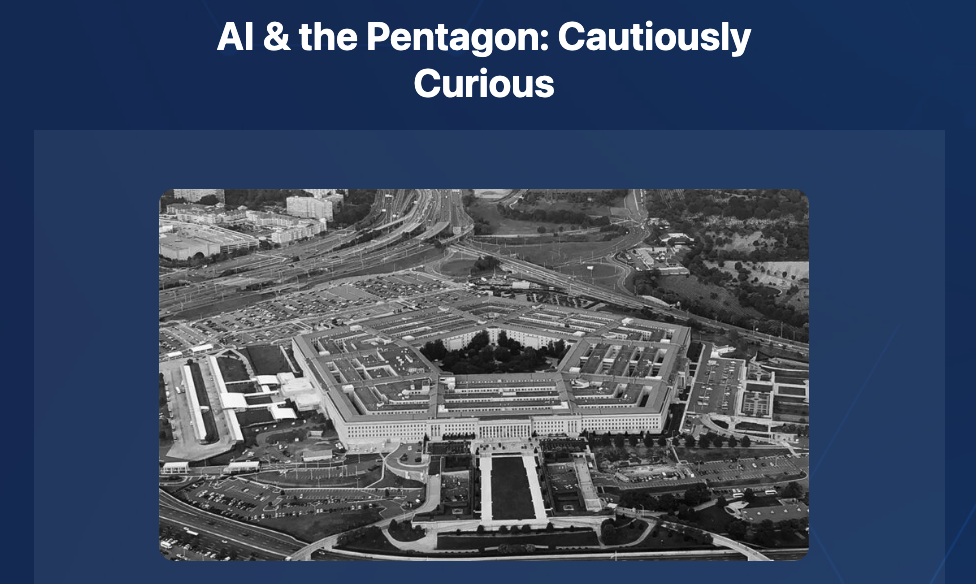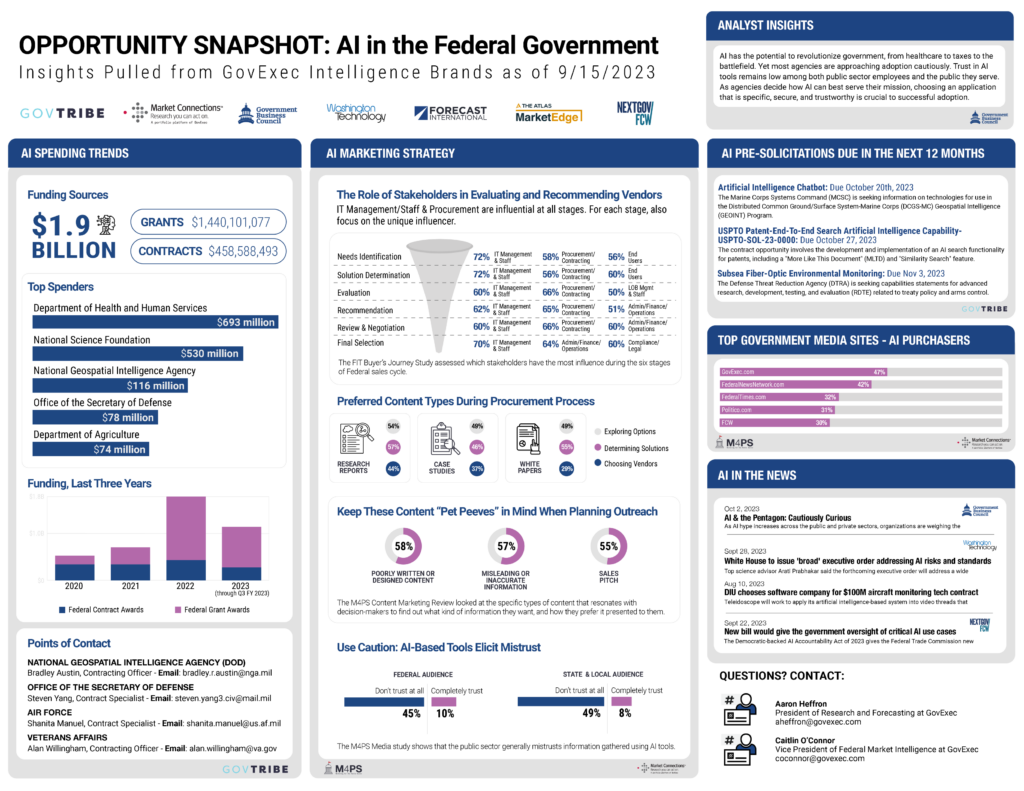artificial intelligence
By Chelsea Jarosh, Industry Analyst at Government Business Council
The White House announced on October 30th, 2023 that President Biden is issuing an Executive Order on safe, secure, and trustworthy Artificial Intelligence (AI).
The proposed comprehensive strategy should be a vital step toward protecting Americans’ privacy, advancing equity and civil rights, supporting customers and workers, promoting innovation and competition, and advancing American leadership around the world.
As AI’s capabilities evolve and grow, so do the risks and vulnerabilities. The Biden-Harris Administration has directed the following actions to ensure they are protecting Americans from the potential risks of maturing AI systems:
1. AI safety and security
- Require that developers of the most powerful AI systems share their safety test results and other critical information with the U.S. government.
- Develop standards, tools, and tests to help ensure that AI systems are safe, secure, and trustworthy.
- Protect against the risks of using AI to engineer dangerous biological materials.
- Protect Americans from AI-enabled fraud and deception by establishing standards and best practices for detecting AI-generated content and authenticating official content.
- Establish an advanced cybersecurity program to develop AI tools to find and fix vulnerabilities in critical software.
- Order the development of a National Security Memorandum that directs further actions on AI and security.
2. Protecting Americans’ privacy
- Protect Americans’ privacy by prioritizing federal support for accelerating the development and use of privacy-preserving techniques.
- Strengthen privacy-preserving research and technologies.
- Evaluate how agencies collect and use commercially available information.
- Develop guidelines for federal agencies to evaluate the effectiveness of privacy-preserving techniques.
3. Advancing equity and civil rights
- Provide clear guidance to landlords, Federal benefits programs, and federal contractors.
- Address algorithmic discrimination.
- Ensure fairness throughout the criminal justice system.
4. Standing up for consumers, patients, and students
- Advance the responsible use of AI.
- Shape AI’s potential to transform education.
5. Supporting workers
- Develop principles and best practices to mitigate the harms and maximize the benefits of AI for workers.
- Produce a report on AI’s potential labor-market impacts, and study and identify options for strengthening federal support for workers facing labor disruptions.
6. Promoting innovation and competition
- Catalyze AI research across the United States.
- Promote a fair, open, and competitive AI ecosystem.
- Use existing authorities to expand the ability of highly skilled immigrants and nonimmigrants with expertise in critical areas to study, stay, and work in the United States.
7. Advancing American leadership abroad
- Expand bilateral, multilateral, and multi-stakeholder engagements to collaborate on AI.
- Accelerate development and implementation of vital AI standards.
- Promote the safe, responsible, and rights-affirming development and deployment of AI abroad to solve global challenges.
8. Ensuring responsible and effective government use of AI
- Issue guidance for agencies’ use of AI.
- Help agencies acquire specified AI products and services.
- Accelerate the rapid hiring of AI professionals.
The Administration has worked with dozens of allies and partners abroad to ensure an international framework is developed for the use of AI. Although great actionable steps have been taken to safeguard AI; the Administration will continue to work with Congress to pursue bipartisan legislation to continue leading America in the right direction.
What does this mean for you?
As AI continues to be the topic of discussion across Government, Industry, and academia, keeping abreast of opportunities and policy changes is critical.
Download the GBC special report:
– AI in Government: Myths, Legends, Market Realities
Read About AI in the DoD

– AI & the Pentagon: Cautiously Curious
To read more from Chelsea, follow her on LinkedIn.
Written by Susan Rose, Senior Director, Insights and Content
AI is everywhere. We spend much of our time in the GovExec Insights and Research Group looking at how the government is using it. But how about you and your marketing department?
AI-enabled B2G content creation is a powerful tool that can help you create personalized and effective content at a fraction of the cost and time it would take without automation.
Will it replace smart, experienced marketers? No. But it WILL help you get more from your budget.
Examples of where to use AI for B2G content
From creating personalized content to optimizing website design, AI-driven content can be a lifesaver. As I think about its uses in my own marketing and talk to colleagues, I see many ways it can help automate content tasks. Here are some examples:
Generating Personalized Content
AI-powered tools can analyze customer data and generate personalized content tailored to the customer’s individual needs. In B2G marketing, you can take one piece of great content tailored to a Fed Civ audience and use AI to target it to Defense or State and Local audiences. Or you can use AI to change the audience focus, say from C-Suite to procurement. Basically, it can do all the things none of us have time to do, but that elevate marketing campaigns.
- Reporting and Analysis: This is another area where AI makes our jobs so much easier. It can gather data from different sources and feed it to you in easy-to-understand formats. That means you can easily determine if campaigns are getting the return you want and expect.
- Suggesting Keywords and Phrases: AI can suggest keywords and phrases for better search engine rankings. By analyzing customer data, the algorithms can identify the most relevant terms associated with your company and products or services.
- Filtering Out Irrelevant Content: AI-powered technologies can filter out irrelevant or outdated content from websites or other digital platforms in order to keep them up-to-date and easy to navigate. This helps ensure your audience is viewing accurate information, which increases trust in your brand. (Content creators, beware though: if something doesn’t feel right to you, it probably isn’t. AI is a fantastic helper and there have been so many improvements, but at the end of the day, you need to fact-check everything.)
5 Best practices for using AI in B2G content creation
When utilizing AI for B2G content development, there are five best practices to follow.
- 1. Create and/or follow an AI policy for your company. This is critical as the policy establishes guidelines for data collection, storage, and usage. It will mitigate risk and ensure ethical AP practices. So before using AI, make sure you know the policies.
- 2. It is necessary to understand the restrictions of AI-driven content production. Though AI automates tedious tasks — which can also help you reduce time and money spent — it cannot substitute human creativity or sound judgment. Fact-check any AI-generated material before publishing it publicly. This is particularly essential when working with delicate topics or when making statements about goods or services that could have legal implications if the wrong data is presented.
- 3. Set up achievable objectives for each campaign. Focus on particular areas where AI-driven alternatives can provide the most value and create attainable goals that will generate real effects.
- 4. Make use of AI’s capacity to refine content for SEO purposes. By taking advantage of natural language processing (NLP) algorithms and machine learning models, you can guarantee your material is optimized for search engine rankings.
- 5. Construct a feedback mechanism to monitor and modify the process over time. Utilize metrics such as customer satisfaction scores and website traffic to measure the effectiveness of your content creation attempts and adjust your techniques accordingly. With ongoing monitoring and continuous enhancement, you can ensure your AI-driven content projects remain useful and efficient throughout time periods
Final thoughts
I wrote this blog using AI [Bard, to be precise] as an experiment. How much time would I really save? In the end, about 20% of this blog is what Bard generated. I found a LOT of repetition, and a whole bunch of paragraphs that didn’t really say anything. I added some of my own thoughts and deleted paragraphs that were just ridiculous or didn’t add anything useful — and that was about one-third of the original blog.
And my AI grammar checker had several opinions about usage [QuillBot].
However, doing it this way did save me time. More importantly, it gave me a starting point. Editing is always easier than writing. So I consider this a success.
If you want to know exactly what kind of content AI can help you with, get our Marketing for the Public Sector report, Content Marketing Review. The data included is valuable for any public sector marketer, regardless of whether you’re implementing AI.
By Jonathan Sanders, Director, Research, GovExec
The White House has announced its plans to introduce an executive order in the near-future focusing on AI.
With remarks from President Biden from the September 27, 2023 meeting with the President’s Council of Advisors on Science and Technology, he notes he has “a keen interest in AI and convened key experts on how to harness the power of artificial intelligence for good while protecting people from the profound risk it also presents.”
Furthermore, he notes the collaborative efforts made to achieve this vision with world leaders and American technology companies to help set the stage for responsible AI innovation. Fifteen companies have now announced their voluntary commitment to the White House to support safe, secure, and trustworthy development of AI.
Arati Prabhakar, the director of the White House’s Office of Science and Technology Policy, noted regarding the forthcoming AI EO, “It’ll be broad. It really reflects everything that the president sees as possible under existing law to get better at managing risks and using the technology.”
Prabhakar and the White House have both noted the ongoing goal of taking a values-led approach to AI usage and development, building on the AI Bill of Rights released in October 2022.
Biden did not release any concrete details on the upcoming order. Prabhakar noted that a draft bill has already been created to benefit both federal efforts and industry research, and that “we want to seize the great power that this technology has to solve some of our hardest problems”.
President Biden is expected to deliver this executive order this Fall.
What does this mean for you?
As AI continues to be the topic of discussion across Government, Industry, and academia, keeping abreast of opportunities and policy changes is critical.

Get the joint GBC/GovTribe report on the current AI landscape in the federal government (information current as of September 15, 2023).
By Jonathan Sanders, Director, Research, GovExec
On 02/01/23, the US Army released its long anticipated solicitation for AI/ML development processes and technologies, and pathfinder processes to identify militarily relevant technologies.
As noted by initial pre-solicitation in August 2022, the overall objective of this effort is to develop concepts that incorporate visualization, include coalition interconnectivity, allow for the ability to obtain data from all information sources, to include Unattended Ground Sensors, improve situational awareness, and decrease the current analyst workload.In particular, this effort will support contested/dense urban environment operations to include subterranean environments.
In order to advance its AI/ML capabilities, the Army has established a number of programs and initiatives that focus on the development and integration of these technologies into its operations. One such program is the Army AI Task Force, responsible for overseeing the Army’s AI/ML development efforts and providing guidance on the integration of these technologies into the force.
The task force works closely with other military organizations, government agencies, and industry partners to ensure that the Army is at the forefront of AI/ML research and development.
Through the power of GovTribe, we are able to glean some of the likely bidders. The likely bidders tool is a powerful machine learning algorithm combining industry attendees and question & answer lists with those that have past performance similar to this type of work, of which include:
- Discovery Machine Inc.
- Wallaroo Labs Inc.
- Scale Ai, Inc.
- Mile Two LLC
- Prescient Edge Corporation
- Oncospace Inc.
- Systems & Technology Research LLC
- Objectsecurity LLC
- Cerebras Systems Inc.
- DS2 LLC
- And Others
In addition to the above, there have been many small businesses that have received small business funding from the Army Contracting Command in the last year in the same parents NAICs as the current solicitation, of which include:
- Colsa Corporation
- Torch Technologies Inc.
- Galley Power
- Mid-Michigan Research LLC
- 3Dflexible Inc.
- Cornerstone Research Group Inc.
- Precision Combustion Inc
- Autonomous Solutions Inc.
- Kestrel Rechnology LLC
- Molyworks Materials Corporation
- Among others
These ongoing solicitation efforts will ensure that the Army has the knowledge and skills necessary to effectively use and integrate Al/ML technologies into its operations for years to come.
The due date for the current solicitation is 03/08/23.
What this means for you
Overall, the Army’s continued efforts in AI/ML demonstrate its commitment to staying ahead of the curve in modern warfare, and they need your team’s help to do so.
Insights, Research, and YOUR Path to More Awards
GovExec’s Insights & Research Group (comprising Market Connections, Government Business Council, and Leading Brands) and GovTribe can keep you up to date on what is happening in this rapidly changing contract environment.
GovTribe is a collaborative platform that lends business development teams a hand through research and tracking of contracting vehicles as well as targeted intelligence on GSA Federal Supply Schedules, GWACS, IDIQs, and other multiple award vehicles.
Combining the data, insights, and expert analysis you get at Market Connections with the ease, agility, and usability of GovTribe can help you strategically position yourself right where you want to be for future opportunities.
Questions? Please reach out to Jonathan Sanders at jsanders@govexec.com.

Clockwise from top left: images from Terminator, I, Robot and Matrix
Artificial Intelligence (AI), Intelligent Automation (IA) and Robotics Process Automation (RPA) – should we be worried about machines taking over the world? Could Skynet or VIKI really happen in our not-so-distant future? Are we headed towards a Matrix society, or more realistically, should we be worried about our own jobs?
While Hollywood may have captured a more fearful version of a world with AI and robots, in real life, this technology surrounds our personal lives. Just ask Siri or Alexa. From auto-filling words when we start typing to providing us driving directions and recommending our next purchases (surprisingly, to our taste), AI has made our smart homes, smart phones, and virtual assistants ubiquitous in our day-to-day lives.
Federal agencies are also looking at ways that AI and IA can help them streamline processes and become more efficient. They are experimenting with AI for email management, data center optimization and efficient accounts payable, hoping it can help limit administrative hours, improve quality, reduce human error, increase compliance and help agencies add new services to their portfolios.
We recently attended an event hosted by ACT-IAC to get a better understanding of where the market is in terms of AI. Professional organizations such as ACT-IAC allow industry and the public sector to convene and share their challenges while showcasing some current use cases and best practices others might want to implement. Whether you are an agency looking to incorporate AI or a contractor looking to support your agency customer, below are some key takeaways from the event.
- Organizational prep is key.
Start by ensuring the agency’s organizational culture is ready for a monumental change. Before you introduce this strategy, ensure buy-in from leadership and subject-matter experts and that management is involved in the process. Take note of your IT resources prior to embarking.
- Quality of data is important.
In the process evaluation, understand where technology is best applied, and whether the data you have is quality data that when fed, could provide smart outputs. Since AI drives decisions from data by creating an algorithm model from the data points to provide future predictions, the success of AI implementation is dependent upon the ability for AI to manage that data. Create an ecosystem of data sets and platforms.
- Failure is okay.
As part of the planning and prep process, don’t try to “boil the ocean.” Look for quick wins or the lowest hanging fruit. Instead of trying to tackle the enterprise, look for small problems within your work that could benefit. It’s okay to fail as you build out to allow you to course-correct. This may lead you to consider whether to repair or retire attempts. Instead of looking for results in a year, look for smaller outputs every three to six months.
- Look to agencies who are already incorporating these.
Agencies are already embarking at technology incorporation at smaller agencies or department levels. For example, the Department of Treasury is already testing chatbots to support and streamline customer service. The Department of Homeland Security is looking to use AI to help cull data from CPARS to support procurement professionals looking to have a better understanding of vendors. By looking at how other agencies are testing the waters, you can find learning lessons in their mistakes and successes.
Learn more:
ACT-IAC recently released a resource put together by the Artificial Intelligence Working Group, ACT-IAC Emerging Technology Community of Interest: AI Playbook for the US Federal Government. This playbook proposes a process and a series of phases to support the United States Federal Government in its understanding and application of artificial intelligence (AI) technologies to support its mission.





